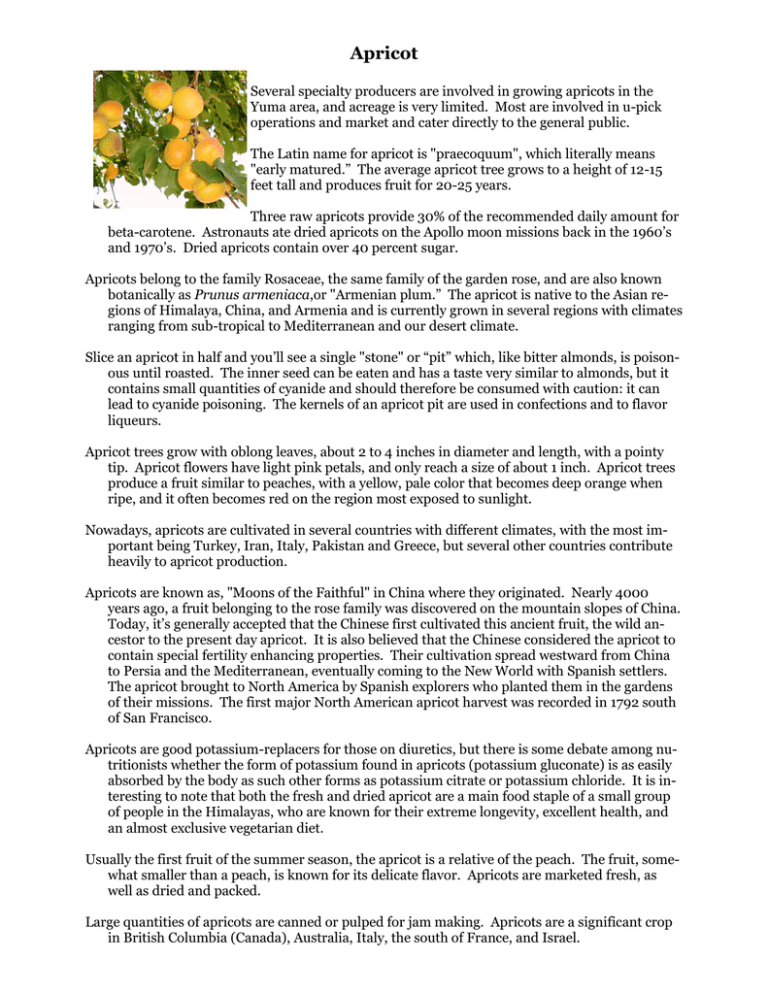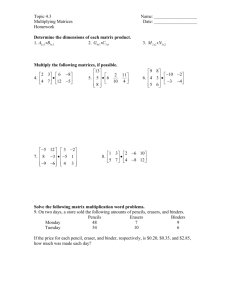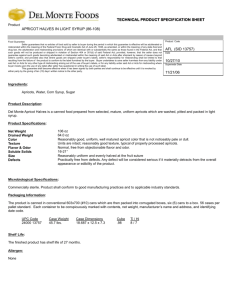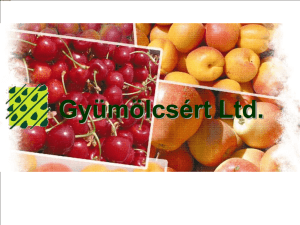Apricot
advertisement

Apricot Several specialty producers are involved in growing apricots in the Yuma area, and acreage is very limited. Most are involved in u-pick operations and market and cater directly to the general public. The Latin name for apricot is "praecoquum", which literally means "early matured.” The average apricot tree grows to a height of 12-15 feet tall and produces fruit for 20-25 years. Three raw apricots provide 30% of the recommended daily amount for beta-carotene. Astronauts ate dried apricots on the Apollo moon missions back in the 1960’s and 1970’s. Dried apricots contain over 40 percent sugar. Apricots belong to the family Rosaceae, the same family of the garden rose, and are also known botanically as Prunus armeniaca,or "Armenian plum.” The apricot is native to the Asian regions of Himalaya, China, and Armenia and is currently grown in several regions with climates ranging from sub-tropical to Mediterranean and our desert climate. Slice an apricot in half and you’ll see a single "stone" or “pit” which, like bitter almonds, is poisonous until roasted. The inner seed can be eaten and has a taste very similar to almonds, but it contains small quantities of cyanide and should therefore be consumed with caution: it can lead to cyanide poisoning. The kernels of an apricot pit are used in confections and to flavor liqueurs. Apricot trees grow with oblong leaves, about 2 to 4 inches in diameter and length, with a pointy tip. Apricot flowers have light pink petals, and only reach a size of about 1 inch. Apricot trees produce a fruit similar to peaches, with a yellow, pale color that becomes deep orange when ripe, and it often becomes red on the region most exposed to sunlight. Nowadays, apricots are cultivated in several countries with different climates, with the most important being Turkey, Iran, Italy, Pakistan and Greece, but several other countries contribute heavily to apricot production. Apricots are known as, "Moons of the Faithful" in China where they originated. Nearly 4000 years ago, a fruit belonging to the rose family was discovered on the mountain slopes of China. Today, it’s generally accepted that the Chinese first cultivated this ancient fruit, the wild ancestor to the present day apricot. It is also believed that the Chinese considered the apricot to contain special fertility enhancing properties. Their cultivation spread westward from China to Persia and the Mediterranean, eventually coming to the New World with Spanish settlers. The apricot brought to North America by Spanish explorers who planted them in the gardens of their missions. The first major North American apricot harvest was recorded in 1792 south of San Francisco. Apricots are good potassium-replacers for those on diuretics, but there is some debate among nutritionists whether the form of potassium found in apricots (potassium gluconate) is as easily absorbed by the body as such other forms as potassium citrate or potassium chloride. It is interesting to note that both the fresh and dried apricot are a main food staple of a small group of people in the Himalayas, who are known for their extreme longevity, excellent health, and an almost exclusive vegetarian diet. Usually the first fruit of the summer season, the apricot is a relative of the peach. The fruit, somewhat smaller than a peach, is known for its delicate flavor. Apricots are marketed fresh, as well as dried and packed. Large quantities of apricots are canned or pulped for jam making. Apricots are a significant crop in British Columbia (Canada), Australia, Italy, the south of France, and Israel. In one ounce apricots contain enough beta carotene to supply 20 percent of your daily vitamin A requirements. Over half the apricots grown commercially are canned. Four ounces of dried apricots can supply four million grams of beta carotene. Dried apricots are over 40 percent sugar. To select the best fresh apricots, look for plump, fairly firm fruit with an orange-yellow to orange color. Avoid green apricots which will not ripen. Convenient and versatile, canned apricots are a quick and healthy addition to cottage cheese, ice cream, desserts, salads and smoothies. Apricots can be used in many recipes that call for peaches or nectarines such as tarts, cobblers, cakes or chutneys. Canned apricots can be puréed in a blender to be used as a fat substitute in recipes calling for oil. Nutritious dried apricots are characteristically dried in halves, are dark orange in color and have an intensely sweet and tart flavor. With the strong sensory appeal of apricots’ delicate, velvety skin and intensely sweet fragrance and flavor, apricot cuttings traveled across the Persian Empire to the Mediterranean where they flourished. Many varieties of the fruit differing in size, color and flavor are still grown with popular appeal throughout the world today. More than 20 kinds of apricots are available. Some favorites are Moorpark, of English origin, with a large, round, orange-red freestone, ripening in the middle of the season; Newcastle, of California origin, with a medium-size, round, orange-yellow freestone; and Royal, of French origin, with a large, oblate, yellow-red freestone, ready early in the season. Many in the Yuma area are experts in the culture of bonsai trees, and an apricot is an excellent bonsai choice. An apricot bonsai tree basically is a standard apricot tree that has been trained to grow into a small size. The tree still produces edible fruits where the only difference is their small size. Other fruit trees that can be made into bonsai include lemon, tangerine, apple, fig, peach, lime, and cherry. Contrary to popular belief, canned apricots do not lose much of their nutritional properties and can be eaten in large quantities. Always look for American canned apricots since those imported from other countries may contain toxic compounds released from the metal can. Dried apricots contain, weight per weight, much more calories, while retaining all of the nutritional properties. This is just a consequence of the lack of water in dried apricots, which makes them much more "concentrated", but they nutritional value is almost the same as raw apricots. Apricot is dried by using two different methods, naturally dried and dried with sulfur. Sulfuring is useful to shorten the time of the drying process, to preserve the natural color, to prevent the product from getting infested with pests, and to increase the storage period. Fruit dried with natural way resulting brown color and different taste. Besides its fresh consumption, apricots are used in making marmalade, jam or jelly and also canned as slices or processed as fruit juice. Kurt Nolte is an area agriculture agent with the Yuma County Cooperative Extension. He can be reached at 928-726-3904.







